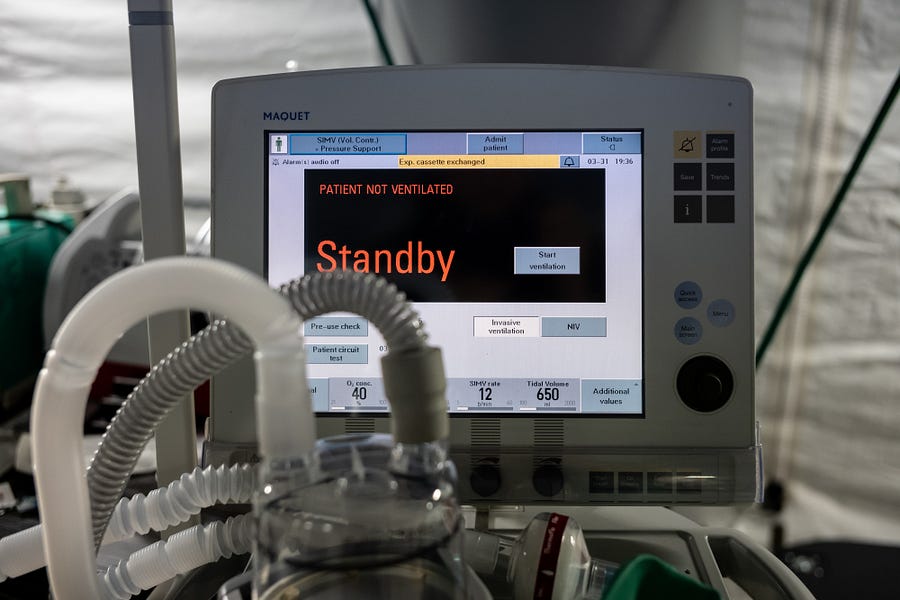The global COVID-19 crisis seems on track to eclipse 9/11 as the leading defining episode of the 21st century thus far. The dystopian trajectory of the pandemic calls for clear, accurate information to ensure efficient distribution and use of resources. Yet one recent example of misinformation related to the likely total number of necessary ventilators (indispensable devices in treating the most serious cases of COVID-19) not only appeared at major media outlets, but even misled the highly respected New England Journal of Medicine. The error conflates the total number of ventilators required with the number of patients who may need the use of a ventilator over the course of the pandemic. How the error spread is a cautionary if convoluted tale.
On March 25, the New York Times published an article titled “Amid Desperate Need for Ventilators, Calls Grow for Federal Intervention.” That same day, former Times reporter and author Alex Berenson pointed out a flaw in the article on Twitter. The article asserted that “[t]he United States currently has between 160,000 and 200,000 ventilators, but could need up to a million machines over the course of the outbreak, according to the Society of Critical Care Medicine.” As Berenson noted, the study in question did not call for 1 million ventilators, but rather that “as many as one million people in the United States [may] need treatment with a ventilator over the course of the pandemic.” [emphasis added]
On the same day the Times posted a correction of that article, the Times published another article that made the same error about the study. The second article, titled “For Dr. Deborah Birx, Urging Calm Has Come With Heavy Criticism,” used the identical inaccurate wording that appeared in the first article: “The United States currently has between 160,000 and 200,000 ventilators but could need up to a million over the course of the outbreak, according to the Society of Critical Care Medicine.” Despite the first correction, the second correction took several days to appear and did not note the Times‘s repetition of the error.
The Times was not the only media organization to propagate the error. While she did not specifically cite the Times as her source, on March 26 CNN’s Brianna Keilar grilled White House adviser Peter Navarro about ventilators, repeatedly demanding of Navarro, “Are we able to get to a million ventilators?” and ultimately scolded him by saying “Peter, you’re wasting everyone’s time. You’re wasting everyone’s time with this. It’s 2020. The president was elected in 2016. Can you get to a million ventilators?”
Navarro pushed back by parroting Keilar’s question, “Oh, ‘we need a million ventilators.’ We can’t possibly get it. That’s like, wildly over what we would need.” Keilar responded, “Peter, that’s from the Society of Critical Care Medicine. They said, I mean, that’s the ceiling, but they say that’s a possibility. You have to know that.” Just as the Times did twice, Keilar misinterpreted the study’s findings. It is unclear if Navarro was familiar with the study, but he did not specifically correct Keilar’s error in real time, nor have Keilar or CNN subsequently issued a correction. Keilar’s sparring with Navarro was widely reported by other media, further spreading the error.
Perhaps the most egregious use of the misinformation comes from the prestigious New England Journal of Medicine. A March 31 New Yorker article on the potential use of 3-D printers to produce ventilators, reported: “The New England Journal of Medicine (NEJM) recently predicted that the United States may need as many as a million ventilators, and estimates put the country’s current stock at no more than a hundred and sixty thousand.” The article links to the NEJM‘s website where, indeed, an article titled “Critical Supply Shortages — The Need for Ventilators and Personal Protective Equipment during the Covid-19 Pandemic” states: “There is a broad range of estimates of the number of ventilators we will need to care for U.S. patients with Covid-19, from several hundred thousand to as many as a million.” To support the claim, the NEJM, ironically enough, links to a New York Times article, but not to either of the articles that originally misstated the study results, but rather an earlier March 13 article that characterized the numbers correctly.
This March 13 Times article referenced a “private webinar convened by the American Hospital Association” with Dr. James Lawler, “an infectious diseases specialist and public health expert at the University of Nebraska Medical Center.”
Dr. Lawler recently presented his own “best guess” projections to American hospital and health system executives at a private webinar convened by the American Hospital Association. He estimated that some 96 million people in the U.S. would be infected. Five out of every 100 would need hospitalization, which would mean close to 5 million hospital admissions, nearly 2 million of those patients requiring intensive care and about half of those needing the support of ventilators.
As it turns out, this webinar is the original source of the “million ventilators” misinformation, but Dr. Lawler was clearly saying that he believed that if an epidemic involved the eventual infection of 96 million people in the U.S., the end result of the most serious cases over time would see “about half of” the 2 million patients requiring intensive care ending up “needing the support of ventilators.”
In a final ironic note, the Society of Critical Care Medicine “study” on which the Times and CNN relied upon refers to Lawler’s statements in “recent AHA webinar on COVID-19” and in a footnote cites… the March 13th New York Times article as its source.
In a fast-moving crisis, the public is demanding information, public officials and health organizations are seeking answers and resources, and competing print and TV media organizations are on tight deadlines. In this case, this perfect storm led to the promulgation of a significant error regarding ventilators, a truly critical resource where clear, regional shortages exist. At this vulnerable time, the country, its leaders and its citizens need clear and accurate information to save lives and put the nation on the road to recovery. This distinctly unfunny comedy of errors should serve as a warning of where lack of rigor in vetting sources can lead.
Photograph of a ventilator by Misha Friedman/Getty Images.






Please note that we at The Dispatch hold ourselves, our work, and our commenters to a higher standard than other places on the internet. We welcome comments that foster genuine debate or discussion—including comments critical of us or our work—but responses that include ad hominem attacks on fellow Dispatch members or are intended to stoke fear and anger may be moderated.
With your membership, you only have the ability to comment on The Morning Dispatch articles. Consider upgrading to join the conversation everywhere.